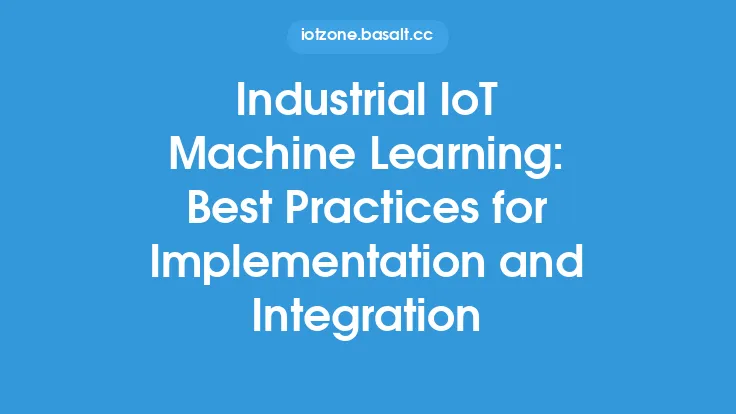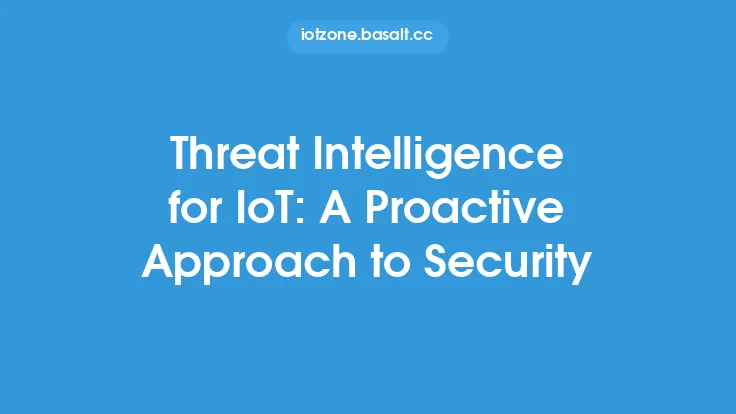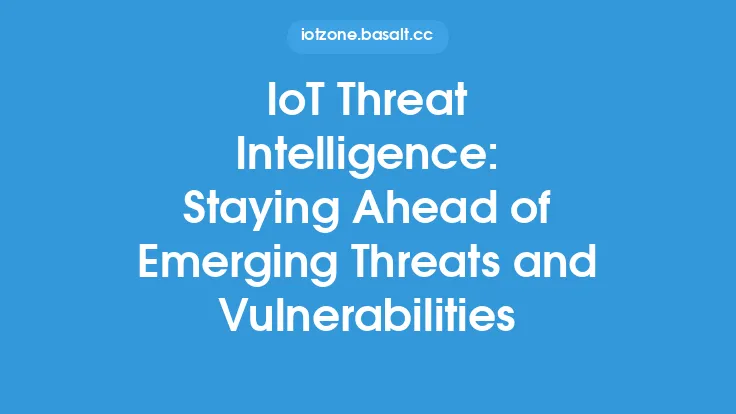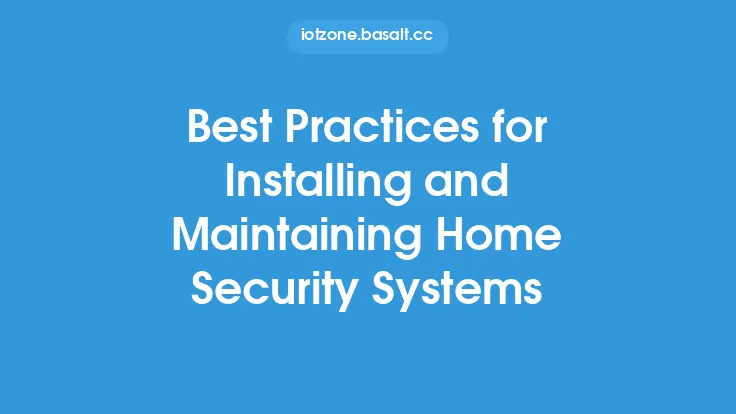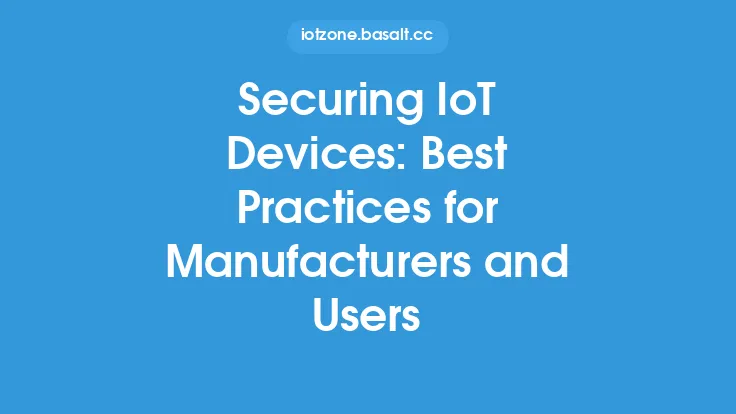The increasing number of Internet of Things (IoT) devices has created a vast attack surface, making it challenging for organizations to secure their networks and devices. Threat intelligence plays a crucial role in helping organizations stay ahead of emerging threats and vulnerabilities. In this article, we will discuss the best practices for implementing threat intelligence in IoT security, providing a comprehensive guide for organizations to enhance their security posture.
Introduction to Threat Intelligence in IoT Security
Threat intelligence is the process of collecting, analyzing, and disseminating information about potential or actual threats to an organization's security. In the context of IoT security, threat intelligence involves gathering information about threats that target IoT devices, networks, and systems. This information can be used to identify vulnerabilities, detect anomalies, and respond to incidents. Threat intelligence can be categorized into three types: strategic, tactical, and operational. Strategic threat intelligence provides a high-level overview of the threat landscape, while tactical threat intelligence focuses on specific threats and vulnerabilities. Operational threat intelligence is used to inform incident response and security operations.
Benefits of Threat Intelligence in IoT Security
The benefits of threat intelligence in IoT security are numerous. It enables organizations to stay ahead of emerging threats and vulnerabilities, reducing the risk of a security breach. Threat intelligence also helps organizations to prioritize their security efforts, focusing on the most critical vulnerabilities and threats. Additionally, threat intelligence can be used to improve incident response, reducing the time and cost associated with responding to a security incident. By leveraging threat intelligence, organizations can also improve their overall security posture, reducing the risk of a security breach and protecting their reputation.
Implementing Threat Intelligence in IoT Security
Implementing threat intelligence in IoT security requires a structured approach. The first step is to define the scope of the threat intelligence program, identifying the types of threats and vulnerabilities to be monitored. The next step is to collect and analyze threat data, using a combination of internal and external sources. Internal sources include network logs, system logs, and security information and event management (SIEM) systems. External sources include threat intelligence feeds, social media, and dark web monitoring. The collected data is then analyzed using various techniques, including machine learning and statistical analysis, to identify patterns and anomalies.
Threat Intelligence Sources
Threat intelligence sources are critical to the success of a threat intelligence program. There are several types of threat intelligence sources, including open-source intelligence (OSINT), closed-source intelligence, and proprietary intelligence. OSINT sources include social media, online forums, and dark web monitoring. Closed-source intelligence sources include threat intelligence feeds, which provide real-time information about emerging threats and vulnerabilities. Proprietary intelligence sources include internal threat intelligence teams, which collect and analyze threat data using a combination of internal and external sources.
Threat Intelligence Tools and Techniques
Threat intelligence tools and techniques are used to collect, analyze, and disseminate threat data. Some common threat intelligence tools include SIEM systems, threat intelligence platforms, and security orchestration, automation, and response (SOAR) systems. SIEM systems are used to collect and analyze network logs and system logs, identifying patterns and anomalies. Threat intelligence platforms are used to collect and analyze threat data from various sources, providing a comprehensive view of the threat landscape. SOAR systems are used to automate incident response, reducing the time and cost associated with responding to a security incident.
Best Practices for Implementing Threat Intelligence in IoT Security
There are several best practices for implementing threat intelligence in IoT security. The first best practice is to define a clear scope and objective for the threat intelligence program, identifying the types of threats and vulnerabilities to be monitored. The next best practice is to use a combination of internal and external threat intelligence sources, providing a comprehensive view of the threat landscape. Additionally, organizations should use threat intelligence tools and techniques, such as SIEM systems and threat intelligence platforms, to collect and analyze threat data. Organizations should also establish a threat intelligence team, which is responsible for collecting, analyzing, and disseminating threat data.
Challenges and Limitations of Threat Intelligence in IoT Security
There are several challenges and limitations of threat intelligence in IoT security. One of the main challenges is the sheer volume of threat data, which can be overwhelming for organizations to collect and analyze. Another challenge is the lack of standardization in threat intelligence, making it difficult for organizations to share and integrate threat data. Additionally, threat intelligence requires significant resources and expertise, which can be a challenge for small and medium-sized organizations. To overcome these challenges, organizations should use threat intelligence tools and techniques, such as machine learning and statistical analysis, to automate the collection and analysis of threat data.
Future of Threat Intelligence in IoT Security
The future of threat intelligence in IoT security is promising, with several emerging trends and technologies. One of the main trends is the use of artificial intelligence (AI) and machine learning (ML) to automate the collection and analysis of threat data. Another trend is the use of cloud-based threat intelligence platforms, which provide a scalable and flexible way to collect and analyze threat data. Additionally, there is a growing focus on integrating threat intelligence with other security technologies, such as security information and event management (SIEM) systems and security orchestration, automation, and response (SOAR) systems. To stay ahead of emerging threats and vulnerabilities, organizations should invest in threat intelligence, using a combination of internal and external sources, tools, and techniques.
Conclusion
In conclusion, threat intelligence is a critical component of IoT security, providing organizations with the information they need to stay ahead of emerging threats and vulnerabilities. By implementing a threat intelligence program, organizations can reduce the risk of a security breach, improve incident response, and enhance their overall security posture. To implement a threat intelligence program, organizations should define a clear scope and objective, use a combination of internal and external threat intelligence sources, and leverage threat intelligence tools and techniques. Additionally, organizations should establish a threat intelligence team and invest in emerging trends and technologies, such as AI and ML, to automate the collection and analysis of threat data. By following these best practices, organizations can enhance their IoT security posture and protect their reputation.
